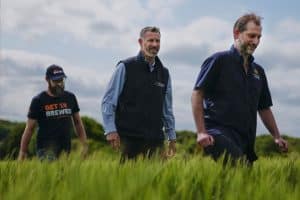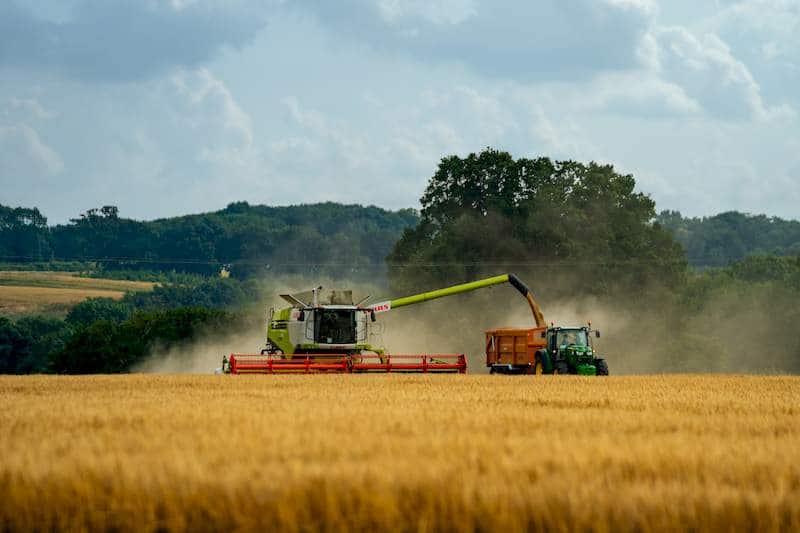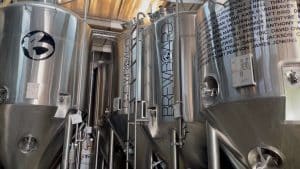
From Field to Fuller’s: The Story of Our Chocolate Malt in London Pride
It’s with great pleasure that we premiere our ‘Field to Fuller’s’ journey, documented by our Northern Irish distribution partners, Get Er Brewed.


by James Marinos
The Summer Barley harvest is a ritual which has taken place for generations, and to this day remains a pivotal moment in the calendar year for maltsters, brewers and of course farmers.
So much depends on the quality and outcome of the revered barley crop, which is used across a wide range of products and markets.
To mark this annual event, we have taken a deeper dive into the first part of the process of how French & Jupps complete the journey from grain to glass.
Video interview with: Andrew Watts, Manager, Wallington Farms.
Insights discussed: Uses | Barley Varieties | Quality & Yield | Equipment | History | Climate Change | Storage | Transportation and more.
Transcript
[00:00:15.340] – James Marinos
I’m here at Gregory’s Farm in Watton At Stone Hertfordshire to watch a tradition that’s been taking place for generations, the summer harvest of barley crop. I’m really excited to be here today to get a bit more insight from the team here at Gregory’s Farm as to just how French and Jupps make that journey from grain to glass.
[00:00:48.140] – Andrew Watts
I’m Andrew Watts. I’m the farm manager for Wallington Farms. We farm a variety of blocks of land in and around the sort of north east part of Hertfordshire. And today we’re actually stood on the edge of a field of malting barley that’s destined for making some decent beer. The barley we’ve got here is a variety called Carat, which is a long established barley for growing, specifically for the purpose of, you know, going into craft coloured malts. And it’s particular characteristic (is it’s very difficult to see when it’s like this) but it’s actually a really bold, plump grain that will actually malt quite well.
[00:01:28.920] – Andrew Watts
We only aim to grow all of our barley for malting and in fact, the vast majority of our crops were growing variety specific to those that French and Jupps prefer for their malt. And so that means early discussions with them and part of the journey. And what you’re seeing here and today in the field is the end of the process for me. But the start of the process for French and Jupps.The malting process , maltsters, are a very sort of traditional and quite often conservative people, but they’re also very specific. So if they find a particular type of barley that works well in their process, then they tend to stick with it. We’ve actually got some barley of another variety, which is a bit newer, that they’re taking something in limited quantities. But this one is our good old tried and tested for them, and we’re pretty confident within reason with a good run of weather that this will produce what they want. So this particular field here and this block where you’ve seen the combine on, that was actually planted last September around about the 27th to 28th of September, and that was when it started its journey.
[00:02:35.910] – Andrew Watts
It was planted into a nice seed bed, and we had plenty of rain as did everybody else. It was a wet year. But then the crop started to grow away. And then my job then is really to walk the crop, monitor it, look at the development and put on the right amount of fertiliser, control any weeds and put on a fungicide or in fact, two, because it’s very important with this to get the grain quality, we do need to make sure that we look after the plant so it doesn’t get diseased to get this nice, bold grain that the maltster wants all being well, we shall combine these fields today, and then the straw will be bailed up to go for animal feed. A lot of our straw we actually chop and put back into the ground. But with the barley, we find it’s a good product to sell. So that goes into local livestock farmers for bedding and for feeding, in fact. So, you know, it has dual uses, but our primary aim is to produce good quality barley. That’s the thing we’re really targeting. So what you’ve got here is three ears of barley and you can see quite plump, well filled grains in there.
[00:03:41.500] – Andrew Watts
The combine obviously strips these whiskers or awns as we technically call them off to leave us with just the grain, which is if I pick one out….. There, you actually have…there’s your grain of Barley
[00:04:02.720] – James Marinos
Has climate change impacted on the growing of the crop?
[00:04:08.200] – Andrew Watts
It’s a very interesting topic. If I look back, people always have memories, they say “Oh in the olden days, we never used to combine this early” and this, that and the other. But you’ll find over the years, actually, things don’t vary that much in my sort of farming lifetime, which is 40 years. Generally speaking, we would combine winter barley somewhere around about the 15th of July, plus or minus a week would be when we would start, and then you’re in the hands of the weather. So that ripening process really hasn’t varied much. What varies more is season on season, particular conditions. We were really quite anxious earlier this year in April when we actually had zero rain, but because it was quite cold, if people can remember back to the frosts, the crop wasn’t under stress. If it had been warm and dry, it would have been really stressed now. And then, of course, we had the rain in May. And, yeah, this is the result.
[00:05:01.420] – James Marinos
What equipment do you use to harvest it? Has that changed over the years?
[00:05:06.180] – Andrew Watts
So the basic principles of combine harvesters have not changed at all. They just get bigger and bigger. So if you think that the farms that I manage Wallington farms. Back in 1994, we had five combines/six. And now we have two. And we gradually reduce the numbers that the machines have got bigger. And we’re actually farming probably 30% more acres than we were then as well. So it’s a dual effect, but it doesn’t really change the principles of it, which is when the crops fit, you want to harvest it, harvest it well, making a job, and more importantly, you want to look after it when it’s got into store. So the block of barley that we’re harvesting this afternoon is an in money is just on 100 acres. And we would expect to harvest that in this afternoon and perhaps a little bit of tomorrow. We can usually do about a hundred acres a day. And we would hope that we would get something round about 300 tonnes of barley from this hundred acre block.
[00:06:02.780] – James Marinos
Speaking of transporting it, I’m hearing some transporting going on here now. How does the process work to getting it to French and Jupps? Do you harvest it over the next two days and send it direct, what’s the next step now?
[00:06:16.500] – Andrew Watts
We actually have got quite a reasonable grain storage set up on the farms we can store everything we combine. So the first stage when it goes back is we would run it over a cleaner, clean out any bits of rubbish, any weed seed to try and make it presentable. And then that would just going to store when they’ve done their analysis. And when we talk to all the people involved, then it will go on from our grain store, it will go in lorries down to Stanstead Abbotts.
[00:06:41.970] – Andrew Watts
And from there into the next stage of its life. Through North Herts Farmers, which is our principle grain trading farmer cooperative. We’ve dealt with French and Jupps for a long time as long as I’ve been here. But we’ve gradually developed a close relationship, so we’re far more specific about the varieties. I want to grow things that they want, because if I can send it 15 miles down the road, rather than sending it 100 miles away to somewhere to me, that makes a lot of sense.

It’s with great pleasure that we premiere our ‘Field to Fuller’s’ journey, documented by our Northern Irish distribution partners, Get Er Brewed.

Ever wondered what goes into a truly special craft beer collaboration? In our ‘Brew Day Secrets’ video, we’ve joined forces with BrewBoard Brewery, Hukins Hops, and The Green Man, Thriplow, for a sneak peek into how our brand-new collaboration beer has been crafted!

South Cambridgeshire’s BrewBoard brewery and The Green Man pub in Thriplow are raising a glass to tradition with a local collaboration, uniting with French & Jupps and Hukins Hops, to create a unique beer that tells a story ‘full circle’ of local provenance.
We’d love to become part of your journey and for you to become part of our story.
If you are looking to create your project using the finest malt with beautiful flavours and aromas, please get in touch,
French & Jupps Ltd, Roydon Road, Stanstead Abbotts, Herts, SG12 8HG
Registered Company No. 00165116
To learn about the journey from field to glass and more detailed explanation of the malting process click below.
Proudly delivering outstanding quality and services for centuries to come.
We pride ourselves in:
Producing the finest quality speciality malts
Providing an inspiring environment for businesses to develop and grow
Supporting the community and local youth programmes
Family owned and driven by core family values.
We are: One team, supportive, honest, respectful and care greatly about our community, local talented youth and the environment.
French & Jupps Ltd, Roydon Road, Stanstead Abbotts, Herts, SG12 8HG